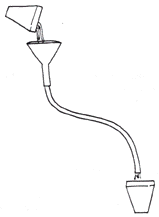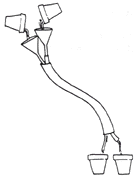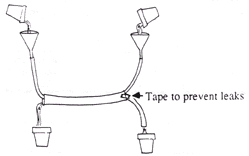Activity 2.2
Staying Warm in Frigid Waters
Materials (for each group of 3/4 students):
- 1/2 inch plastic tubes one meter long
- 1/4 inch copper tubes a meter and a half long
- short sections of flexible tubing to fit on ends of copper
- 4 funnels
- 4 foam cups
- 4 thermometers
- towels
- lab stands or pegboard walls
- safety goggles
- Activity 2.2 Student Worksheet
Procedure :
Part A
- Fill a foam cup with body temperature water (approximately 40 C).
- Pour water through a funnel attached to an end of a 1/2 in. plastic
tube and catch it in a foam cup at the other end. [See Figure 1]

Figure 1
- Take the temperature of the water you caught.
Water Temp:
- Repeat the process but start with cold tap water (approximately 10
C).
Water Temp:
Make a data table showing results from every team in the room. Graph
your results.
Class Data
| |
single tube
cold |
single tube
warm |
same direction
warm inside;
cold outside |
same direction
warm inside;
cold outside |
counter flow
warm inside
cold outside |
| your data |
|
|
|
|
|
| Team 2 |
|
|
|
|
|
| Team 3 |
|
|
|
|
|
| Team 4 |
|
|
|
|
|
| Team 5 |
|
|
|
|
|
| Team 6 |
|
|
|
|
|
Part B
In the human body we have both arteries and veins. They
often are found alongside each other. Both carry flowing liquid at the same
time---arteries move blood away from the heart, veins return
blood flow to the heart. In order to model tubes in close contact without
air we will nest one tube inside the other tube.
- Insert the copper feeder tube into the larger 1/2 in. plastic tube
opening. Attach funnels to the upper ends of both the inside and outside
tubes. [See Figure 2]

Figure 2
- Pour approximately 40 C water into the outer tube and 10 C water into
the inner tube at the same time. Take the temperature of the water on exit
from each tube.
Water Temp:
- Repeat the process with the warm water in the inner tube and the cooler
water in the outer tube.
Water Temp:
Make a data table showing results from every team in the room. Did the
two temperatures of water both end up at the same temperature?
- Repeat the procedure with the funnel at one end of the copper tube
and the opposite end of the outside plastic tube. To do this you may have
to make short extension tubes so each funnel can be held above the tube
to create a flow. [See Figure 3]

Figure 3
- Collect and record data flowing warm on the inside and cool on the
outside.
Water Temp:
- Collect and record data flowing cool on the outside and warm on the
inside.
Water Temp:
Student Worksheet #2.2





![]()